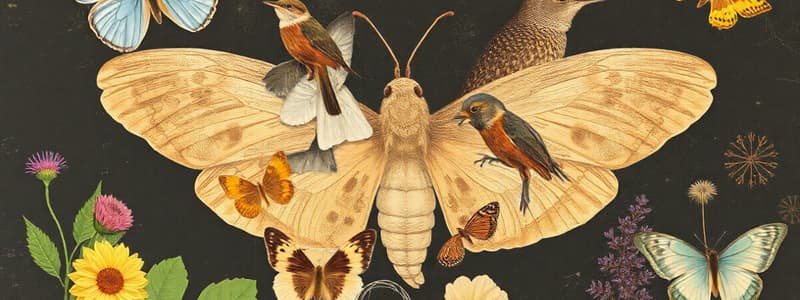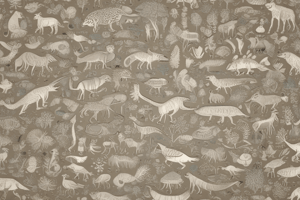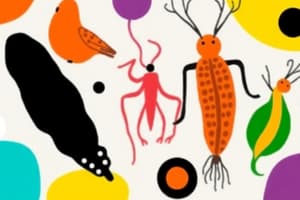Podcast
Questions and Answers
What is classification in biology?
What is classification in biology?
Classification is the scientific practice of identifying, naming, and grouping living organisms.
What is taxonomy/systematics?
What is taxonomy/systematics?
Taxonomy/systematics is the branch of biology that deals with classification.
Name the two categories in the two kingdom classification.
Name the two categories in the two kingdom classification.
Autotroph, Heterotroph
Which of the following is NOT a reason why the two-kingdom classification was insufficient?
Which of the following is NOT a reason why the two-kingdom classification was insufficient?
Who proposed the three-domain classification system and when?
Who proposed the three-domain classification system and when?
Who proposed the five kingdom classification system and when?
Who proposed the five kingdom classification system and when?
Which of the following is NOT a main criteria for the five kingdom classification?
Which of the following is NOT a main criteria for the five kingdom classification?
What type of cell structure do prokaryotes have?
What type of cell structure do prokaryotes have?
What is the movement method of prokaryotes?
What is the movement method of prokaryotes?
What is the reproduction method of prokaryotes?
What is the reproduction method of prokaryotes?
What are some examples of prokaryotes?
What are some examples of prokaryotes?
What is the cell wall composition of kingdom Monera?
What is the cell wall composition of kingdom Monera?
Do organisms in kingdom Monera have a nervous system?
Do organisms in kingdom Monera have a nervous system?
Name 3 extreme habitats where organisms in kingdom Monera live.
Name 3 extreme habitats where organisms in kingdom Monera live.
What does 'archae' mean in archaebacteria?
What does 'archae' mean in archaebacteria?
Name three types of archae bacteria.
Name three types of archae bacteria.
Where do methanogens live?
Where do methanogens live?
Where do halophiles live?
Where do halophiles live?
Name a location where thermoacidophiles live.
Name a location where thermoacidophiles live.
In Eubacteria, well organized nucleus, golgi, mitochondria are _______.
In Eubacteria, well organized nucleus, golgi, mitochondria are _______.
Cell wall is made of _____ in Eubacteria.
Cell wall is made of _____ in Eubacteria.
What is binary fission?
What is binary fission?
Name the 3 types of sexual reproduction in Bacteria.
Name the 3 types of sexual reproduction in Bacteria.
What color do gram positive bacteria stain?
What color do gram positive bacteria stain?
Gram negative bacteria retain stain.
Gram negative bacteria retain stain.
Which of the following is a characteristic of cyanobacteria?
Which of the following is a characteristic of cyanobacteria?
What pigments are present in cyanobacteria?
What pigments are present in cyanobacteria?
What is the role of heterocyst in cyanobacteria?
What is the role of heterocyst in cyanobacteria?
Which of the following is a characteristic of mycoplasm?
Which of the following is a characteristic of mycoplasm?
Name an example of what disease mycoplasm can cause.
Name an example of what disease mycoplasm can cause.
Give one characteristic of Chrysophytes.
Give one characteristic of Chrysophytes.
What type of nutrition do Chrysophytes have?
What type of nutrition do Chrysophytes have?
What is the reproduction type of Chrysophytes?
What is the reproduction type of Chrysophytes?
Give one characteristic of Dinoflagellates.
Give one characteristic of Dinoflagellates.
What type of nutrition do Dinoflagellates have?
What type of nutrition do Dinoflagellates have?
What is the reproduction type of Dinoflagellates?
What is the reproduction type of Dinoflagellates?
What are the 2 types of asexual reproduction of Euglenophyta?
What are the 2 types of asexual reproduction of Euglenophyta?
Flashcards
Classification
Classification
The scientific practice of identifying, naming, and grouping living organisms.
Taxonomy/Systematics
Taxonomy/Systematics
The branch of biology focused on classifying and naming organisms.
Autotroph
Autotroph
Organisms that produce their own food, such as plants, with cell walls and don't locomotate.
Heterotroph
Heterotroph
Signup and view all the flashcards
Archaebacteria
Archaebacteria
Signup and view all the flashcards
Methanogens
Methanogens
Signup and view all the flashcards
Halophiles
Halophiles
Signup and view all the flashcards
Thermoacidophiles
Thermoacidophiles
Signup and view all the flashcards
Eubacteria
Eubacteria
Signup and view all the flashcards
Cocci
Cocci
Signup and view all the flashcards
Bacilli
Bacilli
Signup and view all the flashcards
Spirilla
Spirilla
Signup and view all the flashcards
Gram-positive bacteria
Gram-positive bacteria
Signup and view all the flashcards
Gram-negative bacteria
Gram-negative bacteria
Signup and view all the flashcards
Binary Fission
Binary Fission
Signup and view all the flashcards
Bacterial Conjugation
Bacterial Conjugation
Signup and view all the flashcards
Transformation
Transformation
Signup and view all the flashcards
Transduction
Transduction
Signup and view all the flashcards
Cyanobacteria
Cyanobacteria
Signup and view all the flashcards
Mycoplasma
Mycoplasma
Signup and view all the flashcards
Kingdom Protista
Kingdom Protista
Signup and view all the flashcards
Chrysophytes
Chrysophytes
Signup and view all the flashcards
Dinoflagellates
Dinoflagellates
Signup and view all the flashcards
Euglenophyta
Euglenophyta
Signup and view all the flashcards
Slime Mould
Slime Mould
Signup and view all the flashcards
Kingdom Fungi
Kingdom Fungi
Signup and view all the flashcards
Sexual cycle in fungi
Sexual cycle in fungi
Signup and view all the flashcards
Aseptate hyphae
Aseptate hyphae
Signup and view all the flashcards
Deuteromycetes
Deuteromycetes
Signup and view all the flashcards
Protozoa
Protozoa
Signup and view all the flashcards
Viruses
Viruses
Signup and view all the flashcards
Viroids
Viroids
Signup and view all the flashcards
Lichens
Lichens
Signup and view all the flashcards
Study Notes
Biological Classification
- Classification involves identifying, naming, and grouping living organisms, and are considered scientific practices.
- Taxonomy or Systemics is the branch of biology focused on classification.
Two Kingdom Classification
- Involves Autotrophs like plants; Cellwall, donot locomotate.
- Involves Heterotrophs like animals; Holozoic, donot locomotate.
Why Two Kingdom Classification Was Not Sufficient
- Prokaryotes and eukaryotes were grouped together.
- Bacteria and cyanobacteria ended up in the plant kingdom.
- Heterotrophs and autotrophs were placed together; fungi (heterotroph) ended up with plants.
- There was no differentiation between unicellular and multicellular organisms.
- Protozoans (unicellular) ended up with multicellular animals.
- Simple organisms were placed with highly complex organisms.
- Protozoans ended up with humans in the animal kingdom and bacteria ended up in the plant kingdom.
Three Domain Classification
- Carl Woese proposed the Three Domain Classification in 1990.
- Carl Woese won the national medal of science in November 2000.
- A new category for classification of life was created: the domain.
- The domain is a classification category above the kingdom.
Five Kingdom Classicication
- Proposed by R.H. Whittaker in 1969.
- Main criteria for classification include the following:
- Complexity of cell structure; prokaryotic or eukaryotic.
- Body organization; unicellular or multicellular.
- Mode of nutrition; autotroph, heterotroph, or holozoic.
- Lifestyle; producer, consumer, or decomposer.
- Phylogenetic relationship; evolutionary history.
Five Kingdom Classification: Monera (Prokaryote)
- The cell structure is unicellular prokaryotic.
- Nutrition is absorptive or photosynthetic.
- Movement is by flagella using tubulin.
- Reproduction is asexual.
- Includes bacteria and cyanobacteria (blue green algae).
Five Kingdom Classification: Protista (Protozoa)
- The cell structure is unicellular eukaryotic.
- Nutrition is absorptive or photosynthetic.
- Movement is by flagella, cilia, streaming.
- Reproduction is both asexual and sexual.
- Includes Phytoplankton and Zooplankton.
Five Kingdom Classification: Fungi
- Multicellular eukaryotes.
- The cell structure contains a chitinous cell wall.
- Nutrition is heterotrophic; absorptive, saprobic.
- Reproduction is both asexual and sexual.
- Yeasts (Unicellular) moulds and mushrooms, belong here.
Five Kingdom Classification: Plantae
- Cell structure: cellulosic cell wall, presence of plastids
- Nutrition: Autotrophic
- Movement: Non-motile
- Reproduction: Both asexual and sexual
- Includes algae, Bryophytes, ferns, gymnosperms and Multicelled eukaryotes.
Five Kingdom Classification: Animalia
- Cell structure: without cell wall, and plastids
- Nutrition: Heterotrophic
- Movement: Highly motile
- Reproduction: Both asexual and sexual
- Includes Sponges, Invertebrates, vertebrates and Multicelled eukaryotes
Kingdom Monera
- Includes prokaryotic unicellular organisms.
- Are cosmopolitan (i.e., found everywhere)
- Live in extreme habitats like hot springs and snow, and can exist as endoparasites.
- The cell wall is non-cellular (peptidoglycan) = polysaccharide + amino acids.
- Motility is achieved by flagella, gliding, or the organism may be non-motile.
- Nutrition is autotrophic.
- Sexual reproduction involves conjugation, transduction, and transformation.
- Asexual reproduction occurs via binary fission.
- A nervous system is absent..
Archaebacteria
- Archaebacteria means ancient or primitive.
- Prokaryotic and microscopic oldest anaerobic bacteria
- Live in very harsh habitats
- Possess a rigid cell wall of peptidoglycan (muramic acid).
- Three types of archae bacteria include the following:
- Methanogens
- Halophiles
- Thermoacidophiles.
Methanogens
- Live in marshy places, swamps, and the guts of cattle and termites.
- Methane makers.
Halophiles
- Thrive in salt.
- Live in the Dead Sea, the Great Salt Lake, and salt evaporation ponds.
- They are anaerobic bacteria which develop a purple-colored pigment under high light intensity and produce ATP.
Thermoacidophiles
- "Thermo" means heat.
- Live in hot sulfur springs.
- Prefer temperatures above 60°C.
- Can live below freezing, like the ocean waters around Antarctica.
Eubacteria
- "Eu" means True.
- Unicellular, prokaryotic organisms.
- Possess cell walls made of peptidoglycan.
- Lack a well-organized nucleus, Golgi apparatus, and mitochondria (absent).
- Smallest of all living organisms
Classification of Bacteria (on Shape)
-
Bacteria exist in spheres (cocci):
-
Diplococci (e.g., Streptococcus pneumoniae).
-
Streptococci (e.g., Streptococcus pyogenes).
-
Tetrad.
-
Staphylococci (e.g., Staphylococcus aureus).
-
Sarcina (e.g., Sarcina ventriculi).
-
Bacteria exists in rods (bacilli):
-
Chain of bacilli (e.g., Bacillus anthracis).
-
Flagellate rods (e.g., Salmonella typhi).
-
Spore-former (e.g., Clostridium botulinum).
-
Bacteria exist in Spirals:
-
Vibrios (e.g., Vibrio cholerae).
-
Spirilla (e.g., Helicobacter pylori).
-
Spirochaetes (e.g., Treponema pallidum).
Division of Bacteria on the Basis of Presence of Flagella
- Monotrichous: single flagellum
- Cephalotrichous: multiple flagella located at one pole of the cell
- Amphitrichous: flagella at both poles of the cell
- Peritrichous: flagella surrounding the cell
- Lophotrichous
- Atrichous: no flagella.
Distinguishing Gram-Positive and Gram-Negative Bacteria
- Gram-positive:
- Retain stain; Yes, purple
- Cell wall; Smooth (20-80nm)
- Teichoic acid; Present
- Murein; 70-80 %
- Susceptible to antibiotics; Yes, few are pathogenic
- Gram-negative:
- Retain stain; Donot
- Cell wall; Wavy (8-12nm)
- Teichoic acid; Absent
- Murein; 10-20%
- Susceptible to antibiotics; Resistant to antibiotic, mostly pathogenic
Bacterial Nutrition
- Heterotrophic (take in food):
- Saprophytic is bacteria of decay.
- Parasitic is eg. Streptococci
- Autotrophic (make food):
- Photosynthetic is eg. Purple sulphur bacteria
- Chemosynthetic is eg. Nitrifying Bacteria
Reproduction in Bacteria
- Cell replicates its DNA.
- Cytoplasmic membrane elongates, separating DNA molecules.
- Cross wall forms as the membrane invaginates.
- Cross wall forms completely.
- Formation and seperation into Daughter cells
Cyanobacteria
- Also known as blue-green algae.
- Can be unicellular, colonial, or form trichomes surrounded by a gelatinous sheath.
- Prokaryotic organisms with cell walls made of peptidoglycan.
- Photosynthetic autotrophs.
- Contain characteristic pigments of c-phycocyanin (blue), c-phycoerythrin, carotene, and chlorophyll a.
- Reproduce via binary fission and fragmentation; sexual reproduction is not reported.
- Some bacteria contain heterocysts for N2 (nitrogen) fixation; this can be seen in nostoc, anabaena, and oscillatoria.
Mycoplasm
- Discovered by Nocard and Roux in 1998.
- Smallest known prokaryotes, lacking a cell wall.
- PPLO (pleuropneumonia-like organism).
- Highly pleomorphic (vary in shape).
- Can cause pneumonia and urethritis in animals.
- Cause diseases like bunchy top of banana, little leaf of bringal, and witches' broom of legumes in plants.
Kingdom Characteristics
- Eubacteria:
- Cell type; Prokaryotic
- Cell structure; Cell wall, peptidoglycan
- Body type; Unicellular
- Nutrition; Autotrophic and heterotrophic
- Example; Enterobacteria and Spirochetes
- Archaebacteria:
- Cell type; Prokaryotic
- Cell structure; Cell wall, no peptidoglycan
- Body type; Unicellular
- Nutrition; Autotrophic and heterotrophic
- Example; Methanogens
- Protista:
- Cell type; Eukaryotic
- Cell structure; Mixed
- Body type; Unicellular and multicellular
- Nutrition; Autotrophic and heterotrophic
- Example; Amoebas, Euglenas and Kelps
- Fungi:
- Cell type; Eukaryotic
- Cell structure; Cell wall, chitin
- Body type; Unicellular and multicellular
- Nutrition; Heterotrophic
- Example; Yeasts and Mushrooms
- Plantae:
- Cell type; Eukaryotic
- Cell structure; Cell wall, cellulose
- Body type; Multicellular
- Nutrition; Autotrophic
- Example; Ferns and Pine trees
- Animalia:
- Cell type; Eukaryotic
- Cell structure; No cell wall
- Body type; Multicellular
- Nutrition; Heterotrophic
- Example; Birds and Earthworms
Kingdom- Protista: Chryosophytes (Diatoms/Desmids (Golden Algae))
- Habit: aquatic
- Nutrition: autotrophic
- Reproduction: Asexual- binary fission and Sexual - fusion of gametes
- Economic important: producers of oceans i.e., phytoplanktons, metal polishing, tooth paste, making sound proof rooms plus insulators, between the walls of refrigerators
Diatoms
- Characterized by being unicellular with a silica-based cell wall.
Dinoflagellates (Golden Brown Photosynthetic Organism)
- Habit: mostly marine, but few are freshwater forms.
- Nutrition: holophytic, with photosynthesis.
- Reproduction:
- Asexual via zoospores.
- Sexual via isogametes or anisogamous.
- Responsible for red tide (red sea) and exhibit bioluminescence.
- An Example is Gonylaux (red tide).
Euglenophyta
- Habit: fresh water form
- Nutrition: mixotrophic
- Reproduction: Sexual reproduction not observed and asexual reproduction is Longitudinal binary fission
- Mixotrophic: create own food via light and are heterotrophic with no light.
Slime Mould
- Habitat: Terrestrial.
- Nutrition: Saprophytic, they engulf organic material from dead decaying twigs and leaves.
- Asexual reproduction: fragmentation, sporangia bearing spores
- Reproduction: Sexual- fusion of gametes
Fungi Kingdom: General Characteristic
- Fungi are found in cool, dark, damp, and moist places and on wet logs and skin.
- Nutrition: saprophytic, parasitic, and symbiotic.
- Thallus: aseptate and septate.
- Cell wall: chitin or fungal cellulose.
- Reproduction: Asexual reproduction via conidia, fragmentation, and spores and sexual reproduction spores formation.
Sexual Cycle in Fungi
- Involves three steps:
- Plasmogamy (when the plasmo equals protoplasm).
- Karyogamy (when the karyon equals the nucleus).
- Meiosis in zygote forms haploid spores.
Dikaryon
- A special type of heterokaryon.
- Long-lasting.
- As cells divide, the n + n state is retained.
Phycomycetes
- Habitat: Moist and damp places, decaying wood
- Nutrition: Saprotroph
- Cell wall: Fungal cellulose
- Thallus: Aseptate (coenocytic, i.e. multinucleated)
- Reproduction:
- Asexual: Zoospore or aplanospore
- Sexual: Zygospore
- Example: Rhizopus (bread mould)
Ascomycetes (Sac Fungi)
- Found in moist and damp places, decaying wood
- Nutrition: Saprotroph, parasitic, decomposers or coprophilus
- Cell wall: Chitin
- Thallus: Septate and branched
- Reproduction:
- Asexual: Conidia, budding
- Sexual: Ascospores
- Example: Yeast, penicillium, aspergillus, neurospora
Basidiomycetes
- Decomposers of wood, wet logs, on the branch of tree, in moist soil
- Nutrition: Saprotroph
- Cell wall: Chitin/fungal cellulose
- Thallus: Septate and branched
- Reproduction:
- Asexual: not seen, but fragmentation occurs through vegetative reproduction.
- Sexual: basidiospores
- Example: Mushroom, puff ball, bracket fungi
Deuteromycetes (Imperfect Fungi)
- Habitat: Litter and involved in mineral recycling
- Nutrition: Saprotroph
- Cell wall: Chitin / fungal cellulose
- Thallus: Septate and branched
- Reproduction: Asexual via conidia, and no sexual reproduction has been reported.
- Trichoderma belongs here.
Protozoa
- Protozoa are aquatic and are fresh water forms.
- Holozoic in nutrition.
- Asexual via Binary fission, Multiple fission and sexual reproduction in amoeba has not yet been reported.
- Also includes Paramecium and Sporozoan via conjugation, or genetic fusion.
- Amoeba, Plasmodium, Paramoecium, Trypanosoma belong here.
Classification of Protozoa Based on Mode of Locomotion
- Amoeboids, which use pseudopodia.
- Ciliates, which use cilia.
- Flagellates, which use flagella.
- Sporozoa, which are non-motile.
Viruses
- These are simple living entities/particles comprised of macromolecules; DNA and RNA and Proteins.
- They are obligate parasites, as they are totally dependent on their host.
- Infect and parasitize all forms of life, including bacteria.
Viruses as Living or Non Living
- They lie on the border line of both:
- Living Characters:
- posses DNA or RNA
- ability to reproduce
- cause infection.
- undergo mutation/genetic recombination.
- Non-Living Characters:
- sub cellular (non cellular).
- do not respire/excrete.
- can be crystallized
Contagium Vivium Fluidum (Infectious Living Fluid)
- Beijerinck coined the Latin name "virus" in 1897 to mean poison.
- Filtered plant juices and found that they caused healthy plants to become sick.
- Stanley crystallized sap from sick tobacco plants in 1935.
- Discovered that viruses were made of nucleic acid and protein.
Discovery of Viruses
- Mayer discovered in 1883 that disease is contagious; small, and may be bacteria.
- Ivanowsky discovered a pathogen and filtration in 1893, that found very small bacteria/toxin.
- Beirjerinck found that it could reproduce only in a host and couldn't be cultivated, or inactivated by alcohol in 1897.
Viroids
- In 1971, T.O. Diener discovered a new infectious agent that was smaller than viruses and cause potato spindle disease.
- Lacks a protein coat.
- Contains RNA of low molecular weight.
Lichens
- Lichens represent a symbiotic association of algae and fungi and are pollution indicators.
- Algal component is called phycobiont (phyco = algal)
- Fungal component is called mycobiont (myco = fungi)
Studying That Suits You
Use AI to generate personalized quizzes and flashcards to suit your learning preferences.




